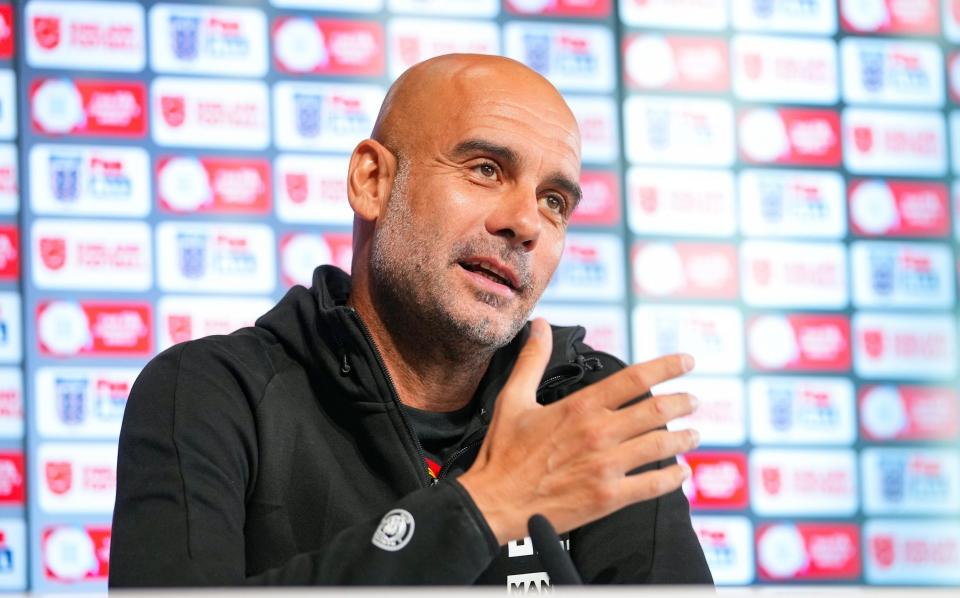This is Pep Guardiola 3.0 – and it could be his best Manchester City side yet

There is a certain degree of bemusement at Manchester City over the reaction to the sale of Raheem Sterling and Gabriel Jesus and the theory that it will damage the Premier League champions.
After all, Sterling was told he could leave last summer with City pushing Tottenham Hotspur to accept him as a makeweight in a proposed deal to sign Harry Kane. Spurs would not do business and Sterling insisted he was not interested, but it proved that his City career was in its twilight.
And while Jesus has also been lavished with praise by Pep Guardiola he never quite became the true heir to Sergio Aguero. He was actually bought to take the striker’s place in 2016, one of Guardiola’s first purchases, as the manager quickly grew frustrated with the Argentinian’s initial reluctance to follow his tactical instructions.
Similar to Sterling, Jesus was told he could go last summer if he wanted to and Juventus showed interest before being put off by City’s asking price – a sum that Arsenal ended up paying.
Both Sterling and Jesus had a year left on their contracts at City and so it made sense for them to leave now. Extracting £100 million for the pair feels like decent enough business even if there is the unusual state of affairs in that they have sold to ‘rivals’ in Chelsea and Arsenal. Ultimately, they were the ones with the means.
No one doubts that the signings have strengthened the two London clubs. One Premier League manager privately declared this week that he confidently expects Jesus to score 20 league goals for Arsenal while Sterling’s pedigree – only Aguero has scored more goals than him under Guardiola at City – is without question.
But City’s strategy has not wavered. Out have gone Sterling (27), Jesus (25) and Fernandinho (37), as planned, and in have come Erling Haaland, Julian Alvarez (both 22) and Kalvin Phillips (26). The club would – not unreasonably – argue that by any measure that represents a clear upgrade.
The final part of the summer refresh was to sign a specialist left-back and allow Oleksandr Zinchenko to leave and although City walked away from their first-choice, Marc Cucurella, after Brighton’s asking price of in excess of £50 million proved too high and Chelsea stepped in, there are other targets. Even so, Guardiola has told City he can cope even if another player is not signed.
Overall it means City have spent £97.9 million and brought in £166.4 million, with the sale of peripheral, younger players added in. It represents a profit of £68.5 million - remarkable for a top club with such ambitions. The figures, of course, are skewed because of Haaland’s release clause of £51 million, which is arguably a quarter of his market value.
But it is not just about the personnel or the finances. It is also about the evolution and the effect it has on the dressing room. It is six years now since Guardiola arrived at City and this has been the busiest summer since he joined. It has also been the summer that Guardiola has wanted for the past couple of years as he looks to bring in new energy – and youth – to a squad that had clearly peaked. It needed a shake-up.
City thought about it last year but there was not the value in the market or they could not prise their targets away. One deal they could do was triggering the £100 million clause in Jack Grealish’s Aston Villa contract but that was partly because they had been tipped off that if they did not then Manchester United would. The effects of the pandemic also complicated negotiations while City would not sell cheaply.
It means we are looking at Pep 3.0 at City. There is still a core of 12 players who have been part of at least three title-winning teams since the 2016-17 campaign – Kyle Walker, Kevin De Bruyne, Ruben Dias, John Stones, Ederson, Bernardo Silva, Aymeric Laporte, Joao Cancelo, Ilkay Gundogan, Rodri, Phil Foden and Riyad Mahrez – but there are new arrivals who will provide new impetus. And keep some of the others on their toes.
There is also a new dynamic: the Haaland focus. It is the first time City have signed such an absolute superstar, one who every leading club in world football wanted, and no matter how big a player you are – even a player such as De Bruyne – adding the most exciting young No 9 to a team has to impress.
And what of City’s style of play? Guardiola's retort to that question is simple: “Why should we change the way we play when we did really quite well in these last seasons?” No-one expects a drastic change, or an alteration of formation, even if it would be strange not to, on occasions, get the ball forward more quickly for Haaland.
Obviously there are legitimate concerns: how quickly will the new players settle and be integrated? Guardiola also deliberately delayed the return for pre-season and City have played fewer warm-up games as he examines the demands of this unique season with a World Cup shoehorned into the middle of it. City may start slowly, as evidenced by the Community Shield defeat last week to Liverpool.
The re-boot is also a show of faith in Foden, who is cemented now as a starter, Mahrez, who has earned a new contract, and Grealish. Cynics may argue that City have no choice but to persist with Grealish but Guardiola has faith and, interestingly, points to the bravery and threat the forward showed as a substitute albeit in losing last season’s Champions League semi-final to Real Madrid. That trophy remains the unfulfilled target as this third coming of Guardiola's City set their sights on a fifth league title in six campaigns.

 Yahoo News
Yahoo News 